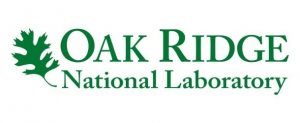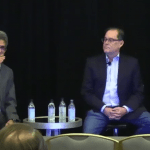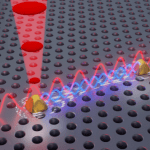Quantum News Briefs February 14: ORNL research suggests satellites may enable better quantum networks, Could “Quantum Telescopes” use quantum entanglement to share photons between observatories? Check Point Software introduces Quantum SD-WAN to protect branch offices + MORE

Quantum News Briefs February 14: ORNL research suggests satellites may enable better quantum networks, Could “Quantum Telescopes” use quantum entanglement to share photons between observatories? Check Point Software introduces Quantum SD-WAN to protect branch offices + MORE
ORNL research suggests satellites may enable better quantum networks
 A study by Oak Ridge National Laboratory researchers has demonstrated how satellites could enable more efficient, secure quantum networks. Quantum News Briefs summarizes.
A study by Oak Ridge National Laboratory researchers has demonstrated how satellites could enable more efficient, secure quantum networks. Quantum News Briefs summarizes.
“We used experiment, emulation and simulation to see what’s needed for high-dimensional quantum cryptography in space and found it’s quite doable,” said ORNL’s Joseph Chapman. “We found qubits and qudits are both viable,”
Chapman’s team used light particles to create entangled pairs of qubits and qudits, meaning one particle from a pair couldn’t be described independently of the other. The team emulated transmission between a ground station and satellite and simulated transmission from orbiting satellites.
UT-Battelle manages Oak Ridge National Laboratory for DOE’s Office of Science, the single largest supporter of basic research in the physical sciences in the United States. DOE’s Office of Science is working to address some of the most pressing challenges of our time. For more information, visit https://energy.gov/science.
Could “Quantum Telescopes” use quantum entanglement to share photons between observatories?
 Matt Williams is the author of a February 13 Universe Today article asking if we are entering the era of quantum telescopes. Quantum News Briefs summarizes below.
Matt Williams is the author of a February 13 Universe Today article asking if we are entering the era of quantum telescopes. Quantum News Briefs summarizes below.
For astronomers, one of the greatest challenges is capturing images of objects and phenomena that are difficult to see using optical (or visible light) telescopes. This problem has been largely addressed by interferometry, a technique where multiple telescopes gather light, which is then combined to create a more complete picture.
Classic interferometry requires that optical links be maintained between observatories, which imposes limitations and can lead to drastically increased costs. In a recent study, a team of astrophysicists and theoretical physicists proposed how these limitations could be overcome by relying on quantum mechanics. Rather than relying on optical links, they propose how the principle of quantum entanglements could be used to share photons between observatories. This technique is part of a growing field of research that could lead to “quantum telescopes” someday.
The study was conducted by researchers from the Brookhaven National Laboratory (BNL) and Stony Brook University in New York, New York. Additional support was provided by Stephen Vintskevich, a theoretical physicist and independent researcher currently based in the United Arab Emirates. The paper that describes their findings recently appeared online and is being reviewed for publication in the scientific journal Optica
Click here to read original article in Universe Today in-entirety.
Check Point Software introduces Quantum SD-WAN to protect branch offices unifying best security & optimized internet connectivity
 Check Point Software Technologies Ltd. (NASDQ: CHKP), a leading provider of cybersecurity solutions globally, has today introduced Check Point Quantum SD-WAN, a new software blade in the Check Point Quantum Gateways. Check Point Quantum SD-WAN combines the highest level of security with optimized network and internet connectivity to protect branch offices from fifth generation of cyberattacks.
Check Point Software Technologies Ltd. (NASDQ: CHKP), a leading provider of cybersecurity solutions globally, has today introduced Check Point Quantum SD-WAN, a new software blade in the Check Point Quantum Gateways. Check Point Quantum SD-WAN combines the highest level of security with optimized network and internet connectivity to protect branch offices from fifth generation of cyberattacks.
In a traditional network architecture, all traffic is routed through the data center before reaching its intended destination in cloud, creating a bottleneck that can slow down performance. To improve performance and reduce costs, enterprises are connecting branches directly to the cloud using Software-defined Wide Area Network (SD-WAN) technology. However, most existing SD-WAN technologies in the market are not built with security in mind. Connecting branch office SD-WANs directly to the internet bypasses traditional datacenter-based security, exposing branch offices to cyberattacks.
According to the latest Miercom report, Check Point Quantum gateways block 99.7% of new malware and phishing attacks while preventing zero-days and ransomware attacks. Deployed at the branch level, it offers an affordable solution that provides the highest level of security, while also optimizing connectivity for users and over 10,000 applications.
Check Point’s Quantum SD-WAN capabilities include:
- Uncompromised branch security:
- No more Zoom interruptions:
- A complete SASE solution:
Click here to read complete GlobeNewswire announcement from Check Point.
The ‘flip-flop’ qubit: Realization of a new quantum bit in silicon controlled by electric signals
 A team led by Professor Andrea Morello at UNSW Sydney has just demonstrated the operation of a new type of quantum bit, called “flip-flop” qubit, which combines the exquisite quantum properties of single atoms with easy controllability using electric signals, just as those used in ordinary computer chips. Quantum News Briefs summarizes from Phys.org.
A team led by Professor Andrea Morello at UNSW Sydney has just demonstrated the operation of a new type of quantum bit, called “flip-flop” qubit, which combines the exquisite quantum properties of single atoms with easy controllability using electric signals, just as those used in ordinary computer chips. Quantum News Briefs summarizes from Phys.org.
“Sometimes new qubits, or new modes of operations, are discovered by lucky accident. But this one was completely by design,” says Prof. Morello. “Our group has had excellent qubits for a decade, but we wanted something that could be controlled electrically, for maximum ease of operation. So we had to invent something completely new.”
Prof. Morello’s group was the first in the world to demonstrate that using the spin of an electron as well as the nuclear spin of a single phosphorus atom in silicon could be used as “qubits”—units of information that are used to make quantum computing calculations. He explains that while both qubits perform exceptionally well on their own, they require oscillating magnetic fields for their operation.
“This new qubit is called ‘flip-flop’ because it’s made out of two spins belonging to the same atom—the electron and the nuclear spin—with the condition that they always point in opposite directions,” says Dr. Rostyslav Savytskyy, one of the lead experimental authors of the paper. Click here to read Phys.org article in-entirety.
Sandra K. Helsel, Ph.D. has been researching and reporting on frontier technologies since 1990. She has her Ph.D. from the University of Arizona.



















